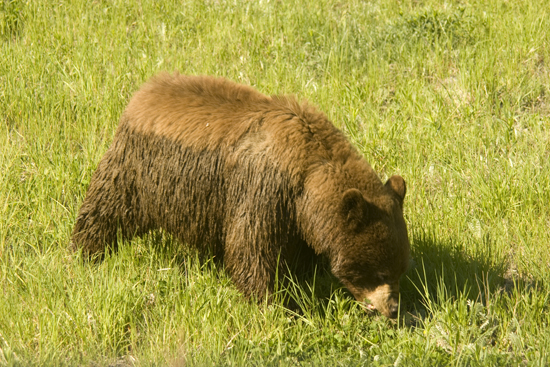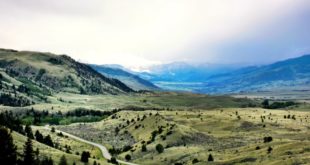First, a grizzly was discovered dead about 50 yards off the road and one-half mile south of LeHardy Rapids, north of Fishing Bridge. The bear was an adult male grizzly, medium brown in color. The bear weighted 576 ½ pounds. The animal was taken to Bozeman, Montana for a necropsy to determine cause of death.
Another bear was found in a ditch next to the road south of Fishing Bridge, about half way between Lake and West Thumb. It is believed this bear was struck and killed by a vehicle sometime Tuesday afternoon. The sub-adult male black bear was black in color, and weighed 79 pounds.
A total of four black bears have been killed inside Yellowstone National Park this year; two in motor vehicle accidents and two problem bears which were euthanized. Three grizzly bears have been killed in the park this year; one by a motor vehicle, one in a trapping accident, and the most recent whose cause of death is still unknown. One grizzly bear was trapped in the park and relocated to Zoo Montana in Billings. And there have been much-publicized incidents outside the East Entrance and the Northeast Entrance where people were killed and the bears put down.
A total of seven is a pretty high number, although three of those bear deaths were due to car collisions, which also reflects the greater number of people visiting Yellowstone (we’re likely to see another record this year). But the fact that there is a lot more interaction between bears and people this year has many wondering what’s different now.
The answer, according to the experts at the Interagency Grizzly Bear Study Team: climate change. We’ve reported repeatedly on the climate change affecting Yellowstone National Park, and specifically about damage to the whitebark pine cones population in Yellowstone’s higher altitudes. It’s easy to dismiss what’s going on with the whitebark pine cones, as most tourists don’t see them, and the notion of these dainty little pine cones sustaining a 500-pound grizzly in a lean spring doesn’t resonate with fans of the mighty bear.
Seems a little unseemly.
But the fact remains that pine cones provide necessary protein to hungry bears in the spring. Take away that crucial protein, and the bear starts the year on a bad footing, heading down to lower ground for food.
And that’s where the people are.
So take these bear deaths as a sign that something askew in the balance of the Greater Yellowstone Ecosystem. You don’t need to be a treehugger to acknowledge that.
RELATED STORIES: Attacking Soda Butte Grizzly was Sick, Stressed; She Snapped; NRDC: Aerial Survey Shows Extensive Whitebark Pine Damage in Yellowstone Ecosystem; Yellowstone’s Whitebark Pine May Be Declared an Endangered Species; White Pines Heavily Impacted by Beetles: NRDC; Can More Grizzlies Can Be Killed With No Ill Effects?; Did Photographer Bait Grizzly into Soda Butte Rampage?; Soda Butte Griz: Light, But Not Malnourished; Soda Butte Griz Cubs Were Malnourished: Zoo Officials; Should Killer Griz Been Allowed to Live?; Confirmed: Cubs Involved in Soda Butte Tragedy Headed to ZooMontana; Mother Griz Put Down After DNA Confirmation; Three Cubs May Go to ZooMontana; Third Griz Cub Trapped; Authorities Waiting on DNA Analysis; Griz Victim Remembered as Avid Outdoorsman; Trap Snares Culprit in Soda Butte Killing: A Mother Griz; Why Did Bear — or Bears — Attack at Soda Butte?; Bear Kills One, Injures Two in Campground Near Yellowstone
We’ve also set up a free Twitter account so you can receive updates on the device of your choice.
 Yellowstone Insider Your Complete Guide to America's First National Park
Yellowstone Insider Your Complete Guide to America's First National Park





